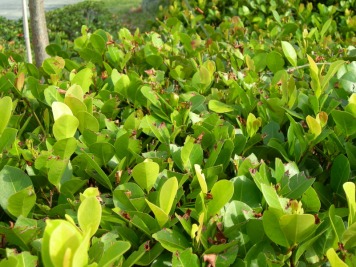
Garden chores for July; look for nutrient deficiencies in ornamentals and palms, correct with chealated micro-elements and slow-release fertilizers, replace plantings damaged by drought, keep on top of weed removal, plant blanket flower, verbena and moss rose for color, plant trees and palms, look for ripe avocados, figs, mangos and bananas.
A rain gauge is the most important landscape management tool in your arsenal. Mount it on a fence or deck where the rain falls freely. Check, record the amount collected and empty daily. Turn the irrigation system on only when your records indicate or the grass shows signs of needing water.
Still looking to plant? Heat tolerant veggies include cassava, yard-long beans, and okra; flowers that hold up to the heat – pentas, porterweed, caladiums and blanketflower.
Take a good at look at your trees and shrubs, if there is any deadwood, remove it anytime. However, now is good to prevent it from blowing around in afternoon thunderstorms or more serious windstorms yet to come.
Take care of yourself, you are important. Wear a hat while gardening.
If your lawn is looking a little peaked, it may not be necessary to use a complete fertilizer containing N-P-K if such has been regularly used. July is a great time to apply a minor element product containing iron, manganese, magnesium, zinc and others.
Do you still have impatiens planted in the Florida landscape? They are not wilting due to lack of water, but from the heat. Remove them and try some flowers that like it hot.
Check container gardens often during the heat; they may need irrigation as often as twice a day to compensate for rapid loss, plant use water to help cool their systems.
“Plant carrots in January and you’ll never have to eat carrots” said an unknown author, it is obvious he or she is not from South Florida; however the sentiment is good, plant when the time is right. If you are new to veggie gardening here, the planting seasons are different, plant carrots in January, not July.
If you have a Bahiagrass lawn, now is the time to re-seed bare or thin areas. Choose the variety ‘Argentine,’ it is the best for lawns, use scarified seed (which is seed that has the hard seed coat broken or thinned making the seed ready to grow) and keep the seed moist until it germinates.
Look for figs; they are ripe this time of year. Eat them right off the tree or collect for preserves which were Granny Cloud’s favorite. There is nothing like fresh fig preserves on homemade biscuits for Sunday Brunch.
The afternoon heat is brutal, so enjoy the garden in print. A hammock in the shade or a favorite recliner inside with the AC on is a great way to while away the hottest hours with a book. Try a factual tome about gardening such as the Florida Gardener’s Guide by Georgia Tasker and Tom MacCubbin or delve into fiction with Nora Roberts’ In the Garden trilogy of Blue Dahlia, Black Rose and Red Lily.
New books gardeners might enjoy include A Philosophy of Gardens by David E. Cooper, Coleus: Rainbow Foliage for Containers and Gardens by Ray Rogers, The Tiny Garden by Jane Hunter, Florida Gardening: The Newcomer’s Survival Manual, Second Edition by Monica Moran Brandies or The Landscape Diaries: Garden of Obsession by Gayatri Carole Rocherolle and Richard Felber.
St Augustine grass and chinch bugs, this bears repeating, be vigilant in scouting for this pest, there has been an outbreak of infestations during the hot weather. Look for chinch bugs in “hot spots” near the driveway, patios, walkways and areas where irrigation doesn’t cover well.
Leave grass clippings on the lawn, most of the time. The rule of thumb is never remove more that 1/3 of the top growth, clipping of this size will break down releasing nutrients back into the soil. However, if the clippings look like hay, remove them to the compost pile.
Veggie gardeners, now is the last time to solarize your plot with clear plastic before the fall garden season. Prepare the garden as if ready to plant, make sure the soil is moist and cover with a thick sheet of clear plastic. Leave in place for 6 – 8 weeks, the accumulated heat will kill weeds, insects, fungi and nematodes.
Dawn or dusk are the best times to work outside and when mosquitoes are most active. Wear light-colored clothes – mosquitoes are attracted to dark colors and a good repellent. Thoroughly inspect your spaces and dump out any standing water where mosquitoes lay their eggs.
Veggie gardeners, now is the time to pull out garden catalogues saved from the spring mailings, plan and order for the fall garden. Make a paper plan; include how much area is to be planted for each variety, planting dates and variety names. Be sure to select varieties suited for Florida’s climate; these grow best and are the most productive.
“From the first dawn of life, all organic beings are found to resemble each other in descending degrees, so that they can be classed in groups under groups. This classification is evidently not arbitrary like the grouping of stars in constellations.” – Charles Darwin
Tip Of The Month!

Shearing is a very popular procedure for pruning shrubs in Florida.
The preponderance of square shrubs has turned the landscape into an un-natural vista of geometric shapes.
The practice also damages leaves and can reduce the lifespan of the shrub. This cocoplum looked brown from a distance, a closer inspection revealed the culprit, hedge shears.
If you must shear a plant, choose small-leafed species and varieties which withstand the practice better than medium and large-leafed plants.
Leave a Reply